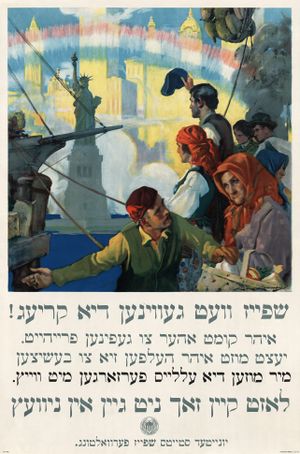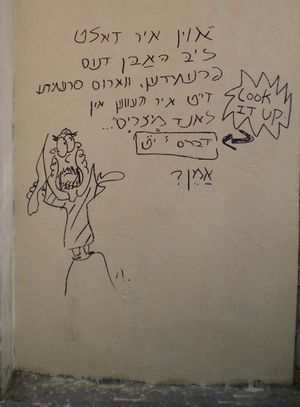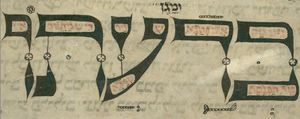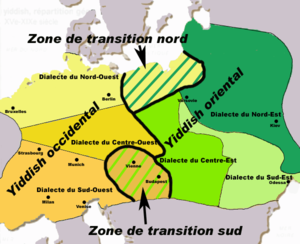يديشية (لغة)
| Yiddish | |
|---|---|
| ייִדיש, יידיש or אידיש yidish/idish/yidish | |
| النطق | [ˈjɪdɪʃ] or [ˈɪdɪʃ] |
| موطنها | Central, Eastern, and Western Europe; Israel; North America; other regions with Jewish populations[1] |
الناطقون الأصليون | (1٫5 million cited 1986–1991 + half undated)e18 |
| Hebrew alphabet (Yiddish orthography) | |
| الوضع الرسمي | |
لغة أقلية معترف بها في | |
| ينظمها | no formal bodies; YIVO de facto |
| أكواد اللغات | |
| ISO 639-2 | yid |
| ISO 639-2 | yid |
| ISO 639-3 | yid – inclusive codeIndividual codes: ydd – Eastern Yiddish yih – Western Yiddish |
| Glottolog | yidd1255 |
| Linguasphere | 52-ACB-g = 52-ACB-ga (West) + 52-ACB-gb (East); totalling 11 varieties |
اللغة اليديشية (ייִדיש، يديش) لغة جرمانية يتحدثها ما يقارب 3 ملايين شخص حول العالم، وأغلبيتهم يهود اشكناز. الاسم يديش هو يديشية لكلمة "يهودية" وقد تكون تقصير لـ"يديش-تايتش" (דיש־טײַטש) أو ألمانية-يهودية.
أصل اللغة اليديشية ليس معروف بالتحديد ولكن بدأت هذه اللغة في حوالي القرن العاشر الميلادي بين اليهود في المانية ربما كلغة تجارية وبينما هرب اليهود إلى شرق أوروبا وخصوصاً بولندا بعد الحروب الصلبية أخذت اللغة كلمات وقوانين من اللغات السلافية.
التاريخ
| اليديشية | גוּט טַק אִים בְּטַגְֿא שְ וַיר דִּיש מַחֲזוֹר אִין בֵּיתֿ הַכְּנֶסֶתֿ טְרַגְֿא |
|---|---|
| Transliterated | gut tak im betage se vaer dis makhazor in beis hakneses trage |
| Translated | May a good day come to him who carries this prayer book into the synagogue. |
أدلة مكتوبة
القرن العشرون

عدد المتحدثون
On the eve of World War II, there were 11 to 13 million Yiddish speakers.[2] The Holocaust, however, led to a dramatic, sudden decline in the use of Yiddish, as the extensive Jewish communities, both secular and religious, that used Yiddish in their day-to-day life, were largely destroyed. Around five million of those killed — 85 percent of the Jews who died in the Holocaust — were speakers of Yiddish.[3] Although millions of Yiddish speakers survived the war (including nearly all Yiddish speakers in the Americas), further assimilation in countries such as the United States and the Soviet Union, along with the strictly monolingual stance of the Zionist movement, led to a decline in the use of Eastern Yiddish. However, the number of speakers within the widely dispersed Orthodox (mainly Hasidic) communities is now increasing. Although used in various countries, Yiddish has attained official recognition as a minority language only in Moldova, Bosnia and Herzegovina, the Netherlands[4] and Sweden.
الوضع كلغة
إسرائيل والصهيونية

الاتحاد السوفيتي السابق
In the Soviet Union during the 1920s, Yiddish was promoted as the language of the Jewish proletariat.

روسيا
الأوبلاست اليهودية الذاتية
السويد
الولايات المتحدة

Modern Yiddish education
انظر ايضا


- List of English words of Yiddish origin
- List of Yiddish-language poets
- List of Yiddish newspapers and periodicals
- The Yiddish King Lear
- Yiddish Book Center
- Yiddish dialects—as spoken in different regions of Europe.
- Yiddish grammar—the structural detail of the language.
- Yiddish literature
- Yiddish orthography—the written representation of the language.
- Yiddishist movement
- Yiddish words used in English—definitions of Yiddish words used in a primarily English context.
- Yinglish
References
- ^ خطأ استشهاد: وسم
<ref>غير صحيح؛ لا نص تم توفيره للمراجع المسماةe18 - ^ خطأ استشهاد: وسم
<ref>غير صحيح؛ لا نص تم توفيره للمراجع المسماةyivo-yiddish - ^ خطأ استشهاد: وسم
<ref>غير صحيح؛ لا نص تم توفيره للمراجع المسماةSprache 1984 p. 3 - ^ "Talen in Nederland | Erkende talen". Rijksoverheid.nl. 2010-07-02. Retrieved 2013-12-08.
Bibliography
- Baumgarten, Jean (2005). Frakes, Jerold C. (ed.). Introduction to Old Yiddish Literature. Oxford: Oxford University Press. ISBN 0-19-927633-1.
- Birnbaum, Solomon (1979, 2nd edition 2016). Yiddish – A Survey and a Grammar. Toronto.
{{cite book}}: Check date values in:|date=(help) - Dunphy, Graeme (2007). "The New Jewish Vernacular". In Reinhart, Max (ed.). Camden House History of German Literature, Volume 4: Early Modern German Literature 1350–1700. pp. 74–79. ISBN 1-57113-247-3.
- Fishman, David E. (2005). The Rise of Modern Yiddish Culture. Pittsburgh: University of Pittsburgh Press. ISBN 0-8229-4272-0.
- Fishman, Joshua A., ed. (1981). Never Say Die: A Thousand Years of Yiddish in Jewish Life and Letters (in Yiddish and English). The Hague: Mouton Publishers. ISBN 90-279-7978-2.
{{cite book}}: CS1 maint: unrecognized language (link) - Frakes, Jerold C (2004). Early Yiddish Texts 1100–1750. Oxford: Oxford University Press. ISBN 0-19-926614-X.
- Herzog, Marvin, ed. (1992–2000). The Language and Culture Atlas of Ashkenazic Jewry. Tübingen: Max-Niemeyer-Verlag in collaboration with YIVO. ISBN 3-484-73013-7.
{{cite book}}: Unknown parameter|displayeditors=ignored (|display-editors=suggested) (help) - Katz, Hirshe-Dovid (1992). Code of Yiddish spelling ratified in 1992 by the programmes in Yiddish language and literature at Bar Ilan University, Oxford University, Tel Aviv University, Vilnius University. Oxford: Oksforder Yiddish Press in cooperation with the Oxford Centre for Postgraduate Hebrew Studies. ISBN 1-897744-01-3.
- Katz, Dovid (1987). Grammar of the Yiddish Language. London: Duckworth. ISBN 0-7156-2162-9.
- Katz, Dovid (2007). Words on Fire: The Unfinished Story of Yiddish (2nd ed.). New York: Basic Books. ISBN 0-465-03730-5.
- Kriwaczek, Paul (2005). Yiddish Civilization: The Rise and Fall of a Forgotten Nation. London: Weidenfeld & Nicolson. ISBN 0-297-82941-6.
- Lansky, Aaron (2004). Outwitting History: How a Young Man Rescued a Million Books and Saved a Vanishing Civilisation. Chapel Hill: Algonquin Books. ISBN 1-56512-429-4.
- Liptzin, Sol (1972). A History of Yiddish Literature. Middle Village, New York: Jonathan David Publishers. ISBN 0-8246-0124-6.
- Margolis, Rebecca (2011). Basic Yiddish: A Grammar and Workbook. Routledge. ISBN 978-0-415-55522-7.
- Rosten, Leo (2000). Joys of Yiddish. Pocket. ISBN 0-7434-0651-6.
- Shandler, Jeffrey (2006). Adventures in Yiddishland: Postvernacular Language and Culture. Berkeley: University of California Press. ISBN 0-520-24416-8.
- Shmeruk, Chone (1988). Prokim fun der Yidisher Literatur-Geshikhte [Chapters of Yiddish Literary History] (in Yiddish). Tel Aviv: Peretz.
{{cite book}}: CS1 maint: unrecognized language (link) - Shternshis, Anna (2006). Soviet and Kosher: Jewish Popular Culture in the Soviet Union, 1923-1939. Bloomington, IN: Indiana University Press.
- Stutchkoff, Nahum (1950). Oytser fun der Yidisher Shprakh [Thesaurus of the Yiddish language] (in Yiddish). New York.
{{cite book}}: CS1 maint: location missing publisher (link) CS1 maint: unrecognized language (link) - Weinreich, Uriel (1999). College Yiddish: An Introduction to the Yiddish language and to Jewish Life and Culture (in Yiddish and English) (6th rev. ed.). New York: YIVO Institute for Jewish Research. ISBN 0-914512-26-9.
{{cite book}}: CS1 maint: unrecognized language (link) - Weinstein, Miriam (2001). Yiddish: A Nation of Words. New York: Ballantine Books. ISBN 0-345-44730-1.
- Wex, Michael (2005). Born to Kvetch: Yiddish Language and Culture in All Its Moods. New York: St. Martin's Press. ISBN 0-312-30741-1.
- Witriol, Joseph (1974). Mumme Loohshen: An Anatomy of Yiddish. London.
{{cite book}}: CS1 maint: location missing publisher (link)
للاستزادة
- YIVO Bleter, pub. YIVO Institute for Jewish Research, NYC, initial series from 1931, new series since 1991.
- Afn Shvel, pub. League for Yiddish, NYC, since 1940; אויפן שוועל, sample article אונדזער פרץ – Our Peretz
- Lebns-fragn, by-monthly for social issues, current affairs, and culture, Tel Aviv, since 1951; לעבנס-פראגן, current issue
- Yerusholaymer Almanakh, periodical collection of Yiddish literature and culture, Jerusalem, since 1973; ירושלימער אלמאנאך, new volume, contents and downloads
- Der Yiddisher Tam-Tam, pub. Maison de la Culture Yiddish, Paris, since 1994, also available in electronic format.
- Yidishe Heftn, pub. Le Cercle Bernard Lazare, Paris, since 1996, יידישע העפטן sample cover, subscription info.
- Gilgulim, naye shafungen, new literary magazine, Paris, since 2008; גילגולים, נייע שאפונגען
وصلات خارجية
- يديشية (لغة) at the Open Directory Project
- Lorne Rozovsky, Path to Extinction: The Declining Health of Jewish Languages
- http://lib.cet.ac.il/pages/item.asp?item=12887 Israeli Government Portal: Yiddish
- 'Hover & Hear' New York Yiddish pronunciations, and compare with equivalents in English and other Germanic languages.
- Articles containing يديشية-language text
- Pages with plain IPA
- Language articles with old Ethnologue 18 speaker data
- Languages with ISO 639-2 code
- Languages with ISO 639-1 code
- Articles containing إنگليزية-language text
- Pages using div col with small parameter
- CS1 errors: unsupported parameter
- CS1 maint: location missing publisher
- Yiddish language
- مواضيع اليهود الأشكناز
- Jewish languages
- Jews and Judaism in Germany
- German dialects
- High German languages
- Languages of Israel
- Languages of Poland
- Languages of Russia
- Languages of Ukraine
- Diaspora languages
- Subject–verb–object languages
- Verb-second languages
- Endangered diaspora languages
- لغات اسرائيل
- لغات جرمانية عليا
- لغات يهودية







